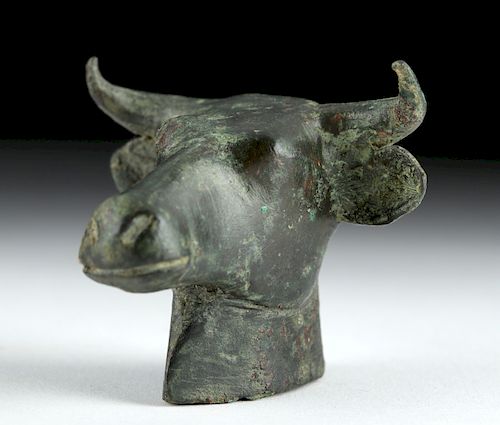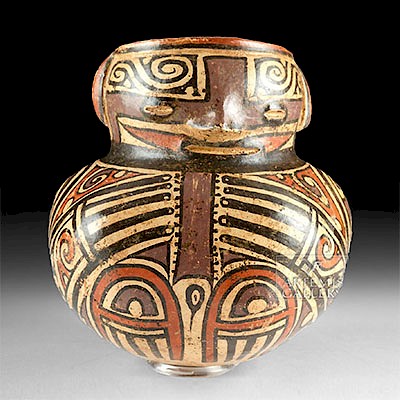Roman Bronze Bucranium - Bull Head
Lot 23b
About Seller
Artemis Fine Arts
686 S Taylor Ave, Ste 106
Louisville, CO 80027
United States
Selling antiquities, ancient and ethnographic art online since 1993, Artemis Gallery specializes in Classical Antiquities (Egyptian, Greek, Roman, Near Eastern), Asian, Pre-Columbian, African / Tribal / Oceanographic art. Our extensive inventory includes pottery, stone, metal, wood, glass and textil...Read more
Estimate:
$800 - $1,200
Absentee vs Live bid
Two ways to bid:
- Leave a max absentee bid and the platform will bid on your behalf up to your maximum bid during the live auction.
- Bid live during the auction and your bids will be submitted real-time to the auctioneer.
Bid Increments
| Price | Bid Increment |
|---|---|
| $0 | $25 |
| $300 | $50 |
| $1,000 | $100 |
| $2,000 | $250 |
| $5,000 | $500 |
| $10,000 | $1,000 |
| $20,000 | $2,500 |
| $50,000 | $5,000 |
| $100,000 | $10,000 |
| $200,000 | $20,000 |
About Auction
By Artemis Fine Arts
Nov 8, 2018
Set Reminder
2018-11-08 10:00:00
2018-11-08 10:00:00
America/New_York
Bidsquare
Bidsquare : Ancient / Ethnographic From Around The World
https://www.bidsquare.com/auctions/artemis-gallery/ancient-ethnographic-from-around-the-world-3598
Ancient art from Egypt, Greece, Italy and the Near East, as well as Asian, Pre-Columbian, Native American, African / Tribal / Oceanic, Spanish Colonial, Russian Icons, Fine art, much more! Artemis Fine Arts info@artemisgallery.com
Ancient art from Egypt, Greece, Italy and the Near East, as well as Asian, Pre-Columbian, Native American, African / Tribal / Oceanic, Spanish Colonial, Russian Icons, Fine art, much more! Artemis Fine Arts info@artemisgallery.com
- Lot Description
Roman, Imperial Period, ca. 1st to 2nd century CE. A finely-molded, cast-bronze bucranium (or bull head) with a stocky ovoid neck, a projecting snout with delineated nostrils, bulging eyes, projecting cupped ears, a planar brow, and a pair of curved horns with sharpened tips. The bull is one of the animals associated with the late Hellenistic and Roman cult of Mithras, in which the killing of the astral bull, the "tauroctony," was of primary importance and was virtually as significant as the Crucifixion to the later Christians. A wonderful example with lustrous green and russet patina. Size: 2" W x 1.625" H (5.1 cm x 4.1 cm).
The bull was considered a deeply divine animal throughout antiquity - a meaningful symbol of the moon, fertility, rebirth, and power. We find the earliest depictions of bulls in Paleolithic cave paintings. Moreover, the veneration of the bull in Anatolia would influence several religious cults in antiquity: from the Minoan practice of bull-jumping in Crete, to the fervent worship of the Apis bull in Egypt, to the sacrificial practices of Roman Mithraism.
Provenance: private East Coast, USA collection
All items legal to buy/sell under U.S. Statute covering cultural patrimony Code 2600, CHAPTER 14, and are guaranteed to be as described or your money back.
A Certificate of Authenticity will accompany all winning bids.
We ship worldwide and handle all shipping in-house for your convenience.
#139665Minor nicks to horns, ears, head, and neck line, with fading to some finer details, and some light encrustations, otherwise intact and very good. Light earthen deposits as well as great green and russet patina throughout.Condition
- Shipping Info
-
All shipping is handled in-house for your convenience. Your invoice from Artemis Gallery will include shipping calculation instructions. If in doubt, please inquire BEFORE bidding for estimated shipping costs for individual items.
-
- Buyer's Premium



 EUR
EUR CAD
CAD AUD
AUD GBP
GBP MXN
MXN HKD
HKD CNY
CNY MYR
MYR SEK
SEK SGD
SGD CHF
CHF THB
THB















